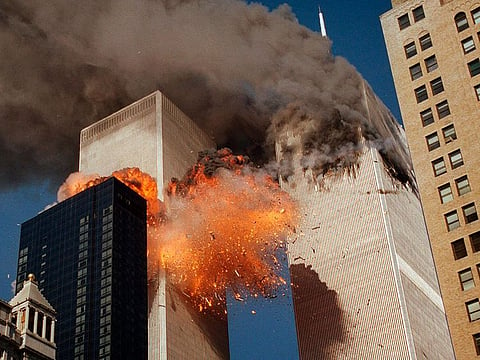I was a brown man in US when 9/11 happened
In its aftermath most ordinary Americans were terribly scared, hurt, anxious, and angry

Many of us have memories of 9/11. I was in the United States then, teaching at a small mid-Western university. My home was right on the campus, within walking distance from the building which housed my office and classroom.
I had a 10:00 a.m. class. As I walked across the greens, I saw workmen in overhauls, listening to their van radio, which was turned up full volume.
All the doors of the van were open. The workers themselves seemed transfixed. The van was parked askew and tilted, half blocking the road, with its left front wheel clambered on the pavement.
Having barely glanced at the morning news at breakfast, I had no have an idea of the devastating attack on the United States by suicide bombers who turned four jetliners into missiles. The only thing that I had registered was that the Dow Jones had crashed. What was going on?
As I hurried inside the classroom, the disturbing visuals of American Airlines flight 11 crashing into North Tower of the WTC at 8:46 a.m. were being flashed on the TV screen. At 9:03 a.m., another flight, United Airlines 175, smashed into the South Tower of WTC.
I'd like to think there were two 9/11s with their differing legaciesProf Makarand R. Paranjape
The two skyscrapers were burning, with billowing black smoke swirling out of them. At 9:37 a.m., a third plane had hurtled into the west wall of the Pentagon in Washington D.C. The whole class watched dazed, helpless, and transfixed, as a fourth plane was diverted to a field in Stonycreek, Pennsylvania at 10:03.
The four plane planes, commandeered and turned into deadly projectiles, had no survivors. All the 265 men, women, and children on board died. In all, close to 3000 people were dead and 6000 injured. Among those trapped in the towering infernos of the WTC, 2606 lost their lives.
They belonged to some 90 nationalities apart from the US. Forty-one were Indians, the highest number after the United Kingdom, which lost 67, and the Dominical Republic, 47.
In addition, 340 firefighters, 72 policemen, and 55 military personnel were killed, as were all the 19 terrorists.
In a special message, our university president asked us not to teach, but hold a counselling session. The first thing I did was to invite all my students observe a minute of silence to condole and pray for the dead. This changed the energy since most students were noticeably agitated. Some were crying too.
I said very gently, “If anyone here is disturbed or distraught or wishes to be alone, she or he may leave if they wish.” No one exited the room. Then I asked if anyone had lost loved ones or acquaintances. Two hands went up. We mourned and meditated together, not just for victims and survivors, but for peace on earth and amity between nations.
Not surprisingly, I was often taken for a Muslim or, at the very least, a foreigner. I received some hostile glares and snide remarks. Being from India, I had a picture of the Taj Mahal on my office door and the Brihadesvara temple inside.
Many thought both were was mosques! Some asked, “Does your religion preach the killing of innocents?” I immediately replied, “No.” Not only because I had read the Quran, but because no religion, including my own, which is Hinduism, condones such heinous violence.
But ordinary Americans were terribly scared, hurt, anxious, and angry. Even the university mail went to a screening centre because of an anthrax scare. People bought rubber gloves and stacked up on groceries. The world changed forever. The US became a different kind of country that I had known it as a graduate student.
In India, we remember 9/11 for another reason. Because it was on this day in 1893 that Swami Vivekananda delivered the first of his six spectacular speeches at the World’s Parliament of Religions, Chicago.
“Sisters and Brothers of America,” he famously said to applause, “It fills my heart with joy unspeakable to rise in response to the warm and cordial welcome which you have given us.”
Foster cultures of peace and mutual respect
Vivekananda introduced the idea of religious pluralism at the Parliament. “We believe not only in universal toleration, but we accept all religions as true.”
He made a passionate plea to the assembly of religious leaders to abolish intolerance: “Sectarianism, bigotry, and its horrible descendant, fanaticism, have long possessed this beautiful earth.
They have filled the earth with violence, drenched it often and often with human blood, destroyed civilisation and sent whole nations to despair…
But their time is come; and I fervently hope that the bell that tolled this morning in honour of this convention may be the death-knell of all fanaticism, of all persecutions with the sword or with the pen, and of all uncharitable feelings between persons wending their way to the same goal.”
We must choose between the two messages of 9/11, between broad-mindedness and radicalism. Each one of us, regardless of which faith tradition we are born, belong, or adhere to, must reject whatever leads to hatred and violence in our own creed, as we do in others.
This also includes the ferocity and oppression of modern ideologies such as Communism and Fascism, along with the offshoots and manifestations the world over.
Instead, we must all strive to foster cultures of peace and mutual respect the world over. This requires a fundamental shift in human consciousness.
Twenty years later, isn’t such a transformation the one rational and positive outcome of the devastating 9/11 catastrophe and its terrible aftermath?
Sign up for the Daily Briefing
Get the latest news and updates straight to your inbox








